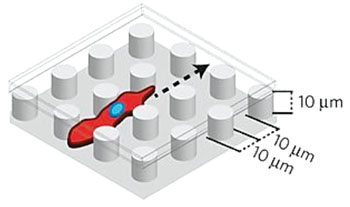Microfluidic Device Monitors Key Step in Development of Tumor Metastases
|
By LabMedica International staff writers Posted on 03 Sep 2014 |

Image: The microfluidic device : as cells undergoing the epithelial-mesenchymal transition move from left to right through the EMT chip, those expressing mesenchymal markers (red) break away and move independently from other cells, while cells expressing epithelial markers (green) continue to move as a collective front (Photo courtesy of Massachusetts General Hospital).

Image: The microfluidic EMT chip showing cells invading an enclosed array of fibronectin-coated polydimethylsiloxane (PDMS) micropillars (Photo courtesy of Massachusetts General Hospital).
A device has been developed that may help study key steps in the process by which cancer cells break off from a primary tumor to invade other tissues and form metastases.
The microfluidic device described as an EMT chip, where EMT stands for epithelial-mesenchymal transition, reveals a fundamental change in cellular characteristics that has been associated with the ability of tumor cells to migrate and invade other sites in the body. Therapies that target this process may be able to slow or halt tumor metastasis.
Bioengineers at Massachusetts General Hospital (Boston, MA, USA) who developed the device allows investigators to follow the movement of cells passing through a comb-like array of micropillars, which temporarily separates cells that are adhering to each other. To establish baseline characteristics of noncancerous cells, the investigators first studied the passage of normal epithelial cells through the array. They observed that those cells moved at the same speed as neighboring cells, reconnecting when they come into contact with each other into multicellular sheets that repeatedly break apart and reseal. Tumor cells, however, passed quickly and more directly through the device and did not interact with nearby cells.
When cells in which the process of EMT had been initiated by genetic manipulation were observed passing through the device, at first they migrated collectively, but soon after encountering the first micropillars, many cells broke away from the collective front and migrated individually for the rest of their trajectory. Some cells appeared to undergo the opposite transition, reverting from individual migration back to collective migration. Subsequent analysis revealed that the slower moving cells that continued migrating together expressed epithelial markers, while the faster moving, independently migrating cells expressed mesenchymal markers. The individually cells migrating also appeared to be more resistant to treatment with chemotherapy drugs.
Daniel Irimia, MD, PhD, an assistant professor of Surgery and the senior author of the study, said, “This device gives us a platform to be used in testing and comparing compounds to block or delay the epithelial-mesenchymal transition, potentially slowing the progression of cancer. Instead of providing a snapshot of cells or tissues at a specific moment, as traditional histology studies do, the new chip can capture the changing dynamics of individual or collective cellular migration.” The study was published on August 17, 2104, in the journal Nature Materials.
Related Links:
Massachusetts General Hospital
The microfluidic device described as an EMT chip, where EMT stands for epithelial-mesenchymal transition, reveals a fundamental change in cellular characteristics that has been associated with the ability of tumor cells to migrate and invade other sites in the body. Therapies that target this process may be able to slow or halt tumor metastasis.
Bioengineers at Massachusetts General Hospital (Boston, MA, USA) who developed the device allows investigators to follow the movement of cells passing through a comb-like array of micropillars, which temporarily separates cells that are adhering to each other. To establish baseline characteristics of noncancerous cells, the investigators first studied the passage of normal epithelial cells through the array. They observed that those cells moved at the same speed as neighboring cells, reconnecting when they come into contact with each other into multicellular sheets that repeatedly break apart and reseal. Tumor cells, however, passed quickly and more directly through the device and did not interact with nearby cells.
When cells in which the process of EMT had been initiated by genetic manipulation were observed passing through the device, at first they migrated collectively, but soon after encountering the first micropillars, many cells broke away from the collective front and migrated individually for the rest of their trajectory. Some cells appeared to undergo the opposite transition, reverting from individual migration back to collective migration. Subsequent analysis revealed that the slower moving cells that continued migrating together expressed epithelial markers, while the faster moving, independently migrating cells expressed mesenchymal markers. The individually cells migrating also appeared to be more resistant to treatment with chemotherapy drugs.
Daniel Irimia, MD, PhD, an assistant professor of Surgery and the senior author of the study, said, “This device gives us a platform to be used in testing and comparing compounds to block or delay the epithelial-mesenchymal transition, potentially slowing the progression of cancer. Instead of providing a snapshot of cells or tissues at a specific moment, as traditional histology studies do, the new chip can capture the changing dynamics of individual or collective cellular migration.” The study was published on August 17, 2104, in the journal Nature Materials.
Related Links:
Massachusetts General Hospital
Latest Pathology News
- AI-Based Liquid Biopsy Approach to Revolutionize Brain Cancer Detection
- AI-Driven Analysis of Digital Pathology Images to Improve Pediatric Sarcoma Subtyping
- AI-Based Model Predicts Kidney Cancer Therapy Response
- Sensitive and Specific DUB Enzyme Assay Kits Require Minimal Setup Without Substrate Preparation
- World’s First AI Model for Thyroid Cancer Diagnosis Achieves Over 90% Accuracy
- Breakthrough Diagnostic Approach to Significantly Improve TB Detection
- Rapid, Ultra-Sensitive, PCR-Free Detection Method Makes Genetic Analysis More Accessible
- Spit Test More Accurate at Identifying Future Prostate Cancer Risk
- DNA Nanotechnology Boosts Sensitivity of Test Strips
- Novel UV and Machine Learning-Aided Method Detects Microbial Contamination in Cell Cultures
- New Error-Corrected Method to Help Detect Cancer from Blood Samples Alone
- "Metal Detector" Algorithm Hunts Down Vulnerable Tumors
- Novel Technique Uses ‘Sugar’ Signatures to Identify and Classify Pancreatic Cancer Cell Subtypes
- Advanced Imaging Reveals Mechanisms Causing Autoimmune Disease
- AI Model Effectively Predicts Patient Outcomes in Common Lung Cancer Type
- AI Model Predicts Patient Response to Bladder Cancer Treatment
Channels
Clinical Chemistry
view channel
First Comprehensive Syphilis Test to Definitively Diagnose Active Infection In 10 Minutes
In the United States, syphilis cases have surged by nearly 80% from 2018 to 2023, with 209,253 cases recorded in the most recent year of data. Syphilis, which can be transmitted sexually or from mother... Read more
Mass Spectrometry-Based Monitoring Technique to Predict and Identify Early Myeloma Relapse
Myeloma, a type of cancer that affects the bone marrow, is currently incurable, though many patients can live for over 10 years after diagnosis. However, around 1 in 5 individuals with myeloma have a high-risk... Read moreMolecular Diagnostics
view channel
Liquid Biopsy Assay Detects Recurrence in CRC Patients Prior to Imaging
The detection of circulating tumor DNA (ctDNA) after treatment is a strong indicator of recurrence in colorectal cancer (CRC), but it often goes undetected due to the low traces of ctDNA present in the blood.... Read more
Ultra Fast Synovial Fluid Test Diagnoses Osteoarthritis and Rheumatoid Arthritis In 10 Minutes
Studies indicate that more than 50% of individuals aged 65 and older experience symptoms of osteoarthritis, while rheumatoid arthritis is a serious chronic condition affecting approximately 1 in 100 people... Read moreHematology
view channel
New Scoring System Predicts Risk of Developing Cancer from Common Blood Disorder
Clonal cytopenia of undetermined significance (CCUS) is a blood disorder commonly found in older adults, characterized by mutations in blood cells and a low blood count, but without any obvious cause or... Read more
Non-Invasive Prenatal Test for Fetal RhD Status Demonstrates 100% Accuracy
In the United States, approximately 15% of pregnant individuals are RhD-negative. However, in about 40% of these cases, the fetus is also RhD-negative, making the administration of RhoGAM unnecessary.... Read moreImmunology
view channel
Stem Cell Test Predicts Treatment Outcome for Patients with Platinum-Resistant Ovarian Cancer
Epithelial ovarian cancer frequently responds to chemotherapy initially, but eventually, the tumor develops resistance to the therapy, leading to regrowth. This resistance is partially due to the activation... Read more
Machine Learning-Enabled Blood Test Predicts Immunotherapy Response in Lymphoma Patients
Chimeric antigen receptor (CAR) T-cell therapy has emerged as one of the most promising recent developments in the treatment of blood cancers. However, over half of non-Hodgkin lymphoma (NHL) patients... Read moreMicrobiology
view channel
New Test Diagnoses Bacterial Meningitis Quickly and Accurately
Bacterial meningitis is a potentially fatal condition, with one in six patients dying and half of the survivors experiencing lasting symptoms. Therefore, rapid diagnosis and treatment are critical.... Read more
Handheld Device Delivers Low-Cost TB Results in Less Than One Hour
Tuberculosis (TB) remains the deadliest infectious disease globally, affecting an estimated 10 million people annually. In 2021, about 4.2 million TB cases went undiagnosed or unreported, mainly due to... Read more
New AI-Based Method Improves Diagnosis of Drug-Resistant Infections
Drug-resistant infections, particularly those caused by deadly bacteria like tuberculosis and staphylococcus, are rapidly emerging as a global health emergency. These infections are more difficult to treat,... Read more
Breakthrough Diagnostic Technology Identifies Bacterial Infections with Almost 100% Accuracy within Three Hours
Rapid and precise identification of pathogenic microbes in patient samples is essential for the effective treatment of acute infectious diseases, such as sepsis. The fluorescence in situ hybridization... Read moreTechnology
view channel
Light Signature Algorithm to Enable Faster and More Precise Medical Diagnoses
Every material or molecule interacts with light in a unique way, creating a distinct pattern, much like a fingerprint. Optical spectroscopy, which involves shining a laser on a material and observing how... Read more
Disposable Microchip Technology Could Selectively Detect HIV in Whole Blood Samples
As of the end of 2023, approximately 40 million people globally were living with HIV, and around 630,000 individuals died from AIDS-related illnesses that same year. Despite a substantial decline in deaths... Read more
Pain-On-A-Chip Microfluidic Device Determines Types of Chronic Pain from Blood Samples
Chronic pain is a widespread condition that remains difficult to manage, and existing clinical methods for its treatment rely largely on self-reporting, which can be subjective and especially problematic... Read more
Innovative, Label-Free Ratiometric Fluorosensor Enables More Sensitive Viral RNA Detection
Viruses present a major global health risk, as demonstrated by recent pandemics, making early detection and identification essential for preventing new outbreaks. While traditional detection methods are... Read moreIndustry
view channel
Cepheid and Oxford Nanopore Technologies Partner on Advancing Automated Sequencing-Based Solutions
Cepheid (Sunnyvale, CA, USA), a leading molecular diagnostics company, and Oxford Nanopore Technologies (Oxford, UK), the company behind a new generation of sequencing-based molecular analysis technologies,... Read more
Grifols and Tecan’s IBL Collaborate on Advanced Biomarker Panels
Grifols (Barcelona, Spain), one of the world’s leading producers of plasma-derived medicines and innovative diagnostic solutions, is expanding its offer in clinical diagnostics through a strategic partnership... Read more



















